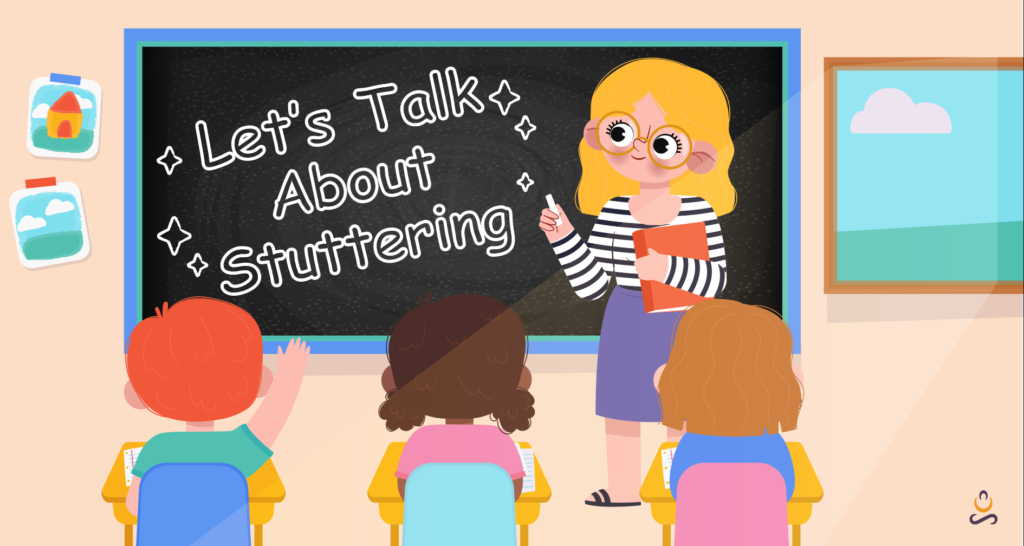The beginning of the school year is an exciting and happy time.
For young students who stutter (CWS), however, it can also be a time of anxiety and fear. It is especially difficult for a child if s/he is the only one who stutters in their grade.
The information on stuttering is readily available today. Still, only a handful of teachers know how to support a stuttering student.
Stuttering is a complex speech disorder and every person stutters differently. So, you might think that putting a stuttering kid at ease is difficult.
Well, that’s not the case.
No matter how severe the condition, you CAN work with a stuttering student.
Here in this post, we will shed light on the top nine ways teachers can work with students who stutter.
1. Let Them Know That “It’s Okay to Stutter”
Sounds pretty basic, right?
Well, when a child refuses to participate in a discussion or oral quiz, simply telling them that stuttering in class is alright can help allay their fears.
Some stuttering kids will avoid answering questions.
So, they may pretend to not know the answer to avoid speaking in front of the entire class.
Let them know that it’s the content of their speech that matters and not how they say it.
2. Foster Good Communication
Set a good example as the teacher.
Maintain eye contact with a kid who trips on some words or phrases. It should be comfortable and natural.
Try to speak at a relaxed pace. Good communication includes not rushing the child.
Do not finish their sentences.
You should also not speak on their behalf. Let them answer questions and participate in group discussions.
3. Treat Students Who Stutter Like Every Other Kid In Class
You should expect the same level of dedication and performance from CWS as you do from your other students.
Allowing CWS to opt-out of presentations or oral tasks may encourage avoidance behavior.
You can, by all means, offer help during the preparatory phase.
Before a stuttering student begins speaking, you can request the class to be quiet and patient.
4. Make Small Changes
Many of us still suffer from anxiety and self-doubt when we have to present in front of an audience.
Stage fright is something most of us have experienced at some point in our lives.
For CWS, stuttering or stammering adds an extra layer of the anxiety to stage fright.

Allow them 5 to 10 minutes of extra to finish their speech.
Encourage voluntary communication and discourage quick call-out answers.
You can adopt a random pattern of turn selection for students to reduce the anticipation among CWS.
5. Inform Other Students
Talk to the child who stutters in your class first. Find out if it is alright to discuss their stuttering in front of their classmates.
Tell the class to not be impatient when a child who stutters is speaking. Stop others from finishing their sentences.
Urge students to support and not mock someone who stutters.
Set up a model wait-time. Make it a practice to wait around 2 seconds to answer a question. Don’t reward students based on who answers the fastest.
6. Talk About Stuttering And Bullying
Introduce life stories of inspirational personalities like Charles van Riper, Joe Biden, Ed Sheeran, and James Earl Jones (the voice of Darth Vader) to normalize speech disfluencies.
Let your students ask questions freely about stuttering and its effects.
Talking more about stuttering is the only way to destigmatize it.

Let everyone know that stuttering doesn’t make a child any less capable or less intelligent.
Make your class a no-bullying zone. Foster an inclusive environment for all students.
Every child needs a safe space to be themselves.
Let your class become that safe zone for everyone, including the kid who stutters.
7. Offer Additional Support
Sometimes, children don’t speak up even when they know the answer. That may be because they are conscious of how they sound.
It can affect their overall performance.
You can become the source of additional support for CWS.
You don’t have to be a speech therapist or a speech-language pathologist in order to be a good listener.
Let your actions show that you care.
A word of encouragement and a positive attitude can make a world of difference.
A child who constantly struggles to express what they think and feel needs all the support they can get.
Seek permission from their parents to introduce them to an anti-stuttering phone app like Stamurai.
Children can become more fluent and confident in communicating through exercises and techniques.
Yes, a speech therapy app can make a real difference.
8. Don’t Offer Unsolicited Advice
For a stuttering student, nothing’s worse than hearing a teacher repeat “slow down” or “take a deep breath.”
You might think you are being helpful when you offer such advice.
However, it’s beyond annoying to someone who has stuttered for as long as they can remember.
They have heard such advice thousands of times.
They already know that such advice does not work.
By offering such advice while a student is talking, you are merely interjecting. It may distract them from the topic.
Such incorrect and untimely advice can also leave them frustrated if you don’t let them finish their sentences.
9. Foster a Positive Learning Environment for Stuttering Students
Becoming a good teacher is easy.
Becoming a great teacher, however, is nothing short of a challenge.
Make sure every child in your class gets the same opportunities.
On many occasions, some children will require extra care and attention. Children who stutter may need your support and encouragement to communicate without fear and hesitation.
Establishing a no-bullying rule will help CWS regain confidence and be themselves. It will also help children, who may have other disorders.
Devote extra time to a stuttering student after class if necessary.
On all other occasions, when accommodations aren’t necessary, never treat a stuttering student any differently from others in the class.










